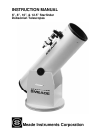
- 5 -
Optical Tube Assembly
The optical tube has been pre-drilled at the Meade factory to
accept all standard accessories.
1. Attaching the Focuser: Lay the tube flat on the floor.
Align the holes in the focuser assembly (1, Fig. 1) with the
four pre-drilled holes in the optical tube. From the
provided hardware, place the four Phillips-head screws
through the holes. Then, carefully reach into the optical
tube and attach a nut and washer to each screw. Tighten
the screws, but do not overtighten; tightening to a firm feel
is sufficient.
2. Attaching the Viewfinder: With the optical tube lying flat
on the floor, align the two holes in the viewfinder bracket
(3, Fig.1) with the pre-drilled holes in the optical tube.
From the supplied hardware, place a screw through each
of the holes. Carefully reach into the optical tube and
attach a nut to each screw. As with the focuser, tightening
to a firm feel is sufficient. Overtightening may result in
damage to the tube's finish. Aligning the viewfinder is
discussed later in this manual.
Your Meade Starfinder telescope was fully assembled, aligned,
and tested at the Meade factory. To ensure safe shipping, the
primary mirror was then removed from the telescope. Locate
the primary mirror cell assembly (Fig 3). Again, take extreme
care not to touch or bump the primary mirror.
3. Installing the Primary Mirror: (Refer to Figure 3) You will
note that there is a colored marker on the rear of the
telescope tube. There is a corresponding colored marker
(3, Fig. 3) on the mirror cell. Carefully slide the mirror cell
into the rear of the tube, ensuring that the two colored
markers line up. Secure the cell to the tube with the four
provided large-headed screws (1, Fig. 3). Again, do not
overtighten the screws. A firm feel is sufficient.
4. Carefully place the assembled optical tube into the
previously assembled base as illustrated in Figure 1. Note
that the two large bearings on the side of the tube
(11, Fig.1) rest in the cutouts of the mount . Also note the
orientation of the tube to the mount; the focuser (1, Fig. 1)
should be on the opposite side from the mount’s Front
Board (10, Fig. 1).
BALANCING THE TELESCOPE
Dobsonian telescopes are designed to move easily, but at the
same time remain in the position they are placed. This is
achieved by carefully balancing the telescope at the Meade
factory. The telescope is balanced for standard accessories.
However, should anything attached to the telescope change,
for example using a larger or smaller eyepiece, or even moving
the primary mirror during collimation, slight imperfections in
balance may occur.
You may find as you change eyepieces or accessories, that the
telescope is out-of-balance. This is a relatively easy problem to
correct. With a little ingenuity, counterweights can be fashioned
by the telescope owner, using fishing sinkers or washers.
THE VIEWFINDER
The Starfinder telescope, as with almost all astronomical
telescopes, presents a fairly narrow field of view to the
observer. As a result, it is sometimes difficult to locate and
center objects in the telescope’s field of view.
The viewfinder, by contrast, is a low-powered, wide-field
sighting scope with crosshairs that enables the easy centering
of objects in the main telescope’s field of view. Standard
equipment with the Starfinder telescope is a viewfinder of 5-
power and 24 mm aperture, called an “5 x 24mm viewfinder.”
Aligning the Viewfinder
In order for the viewfinder to be useful, it must first be aligned
with the main telescope, so that both the viewfinder and the
main telescope are pointing at precisely the same place. To
align the viewfinder, follow this procedure:
1. The viewfinder bracket includes six alignment screws.
Turn the three rear-most alignment screws so that the
viewfinder tube is roughly centered within the viewfinder
bracket, as viewed from the eyepiece-end of the
telescope.
2. Using the standard equipment 25mm eyepiece, point the
main telescope at some easy-to-find, well-defined land
object, such as the top of a telephone pole. Center the
object precisely in the main telescope’s field.
3. While looking through the viewfinder, gently turn one or
more of the three front-most viewfinder alignment screws
until the crosshairs of the viewfinder point at precisely the
same position as the main telescope. During this
procedure, occasionally look through the main telescope
to make sure the object is still centered.
When the object is centered in the viewfinder, confirm that the
v i e w f i n d e r’s crosshairs and the main telescope are now
pointing at precisely the same object. The viewfinder is now
aligned to the main telescope. Unless the alignment screws are
disturbed, the viewfinder will remain aligned indefinitely.
Using the Viewfinder
Now, to locate any object, terrestrial or astronomical, first
center the object on the crosshairs of the viewfinder; the object
will then be centered in the field of the main telescope.
Note: If you intend to use higher observing magnifications, first
locate, center, and focus the object using a low-power eyepiece
(e.g., the 25mm eyepiece). Objects are easier to locate and
center at low powers; higher power eyepieces may then be
employed by changing eyepieces.
COLLIMATION OF THE OPTICAL SYSTEM
Precise collimation, or alignment, of your telescope’s optical
system is essential for good performance. All Meade
telescopes are accurately collimated at the factory prior to
shipment, so collimation adjustments will probably not be
necessary. Nevertheless, take the time now to familiarize
yourself with the following collimation procedure so that you
may recognize a properly collimated instrument and adjust the
collimation yourself, if necessary.
Fig. 3: Installing the Primary Mirror in the Optical Tube Assembly.
(1) Attachment Bolts; (2) Primary Mirror; (3) Alignment Markers;
(4) Counterweight Thread; (5) Collimation Bolts.
1
2
3
5
4
3
1














